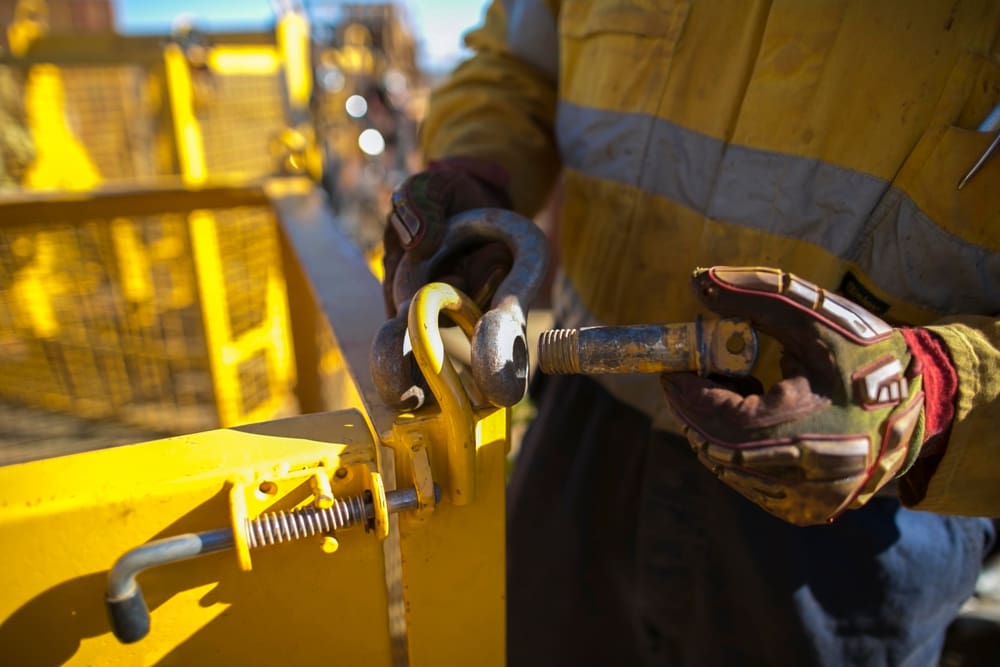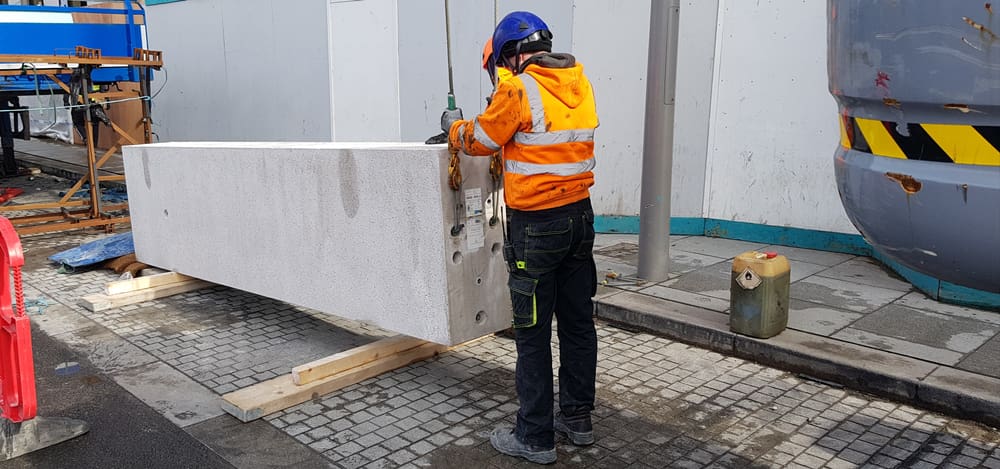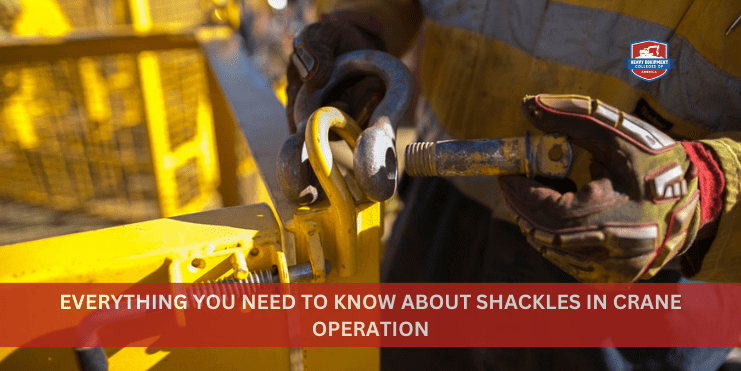From hoisting steel frames to transporting cargo boxes, cranes are used for various applications across industries. But these pieces of heavy equipment can’t operate on their own. Cranes use additional rigging hardware to carry out any task.
One mechanism used in crane operation is a shackle. Let’s take a look below at what a shackle is, what it’s used for, different types of shackles, and how to use them.
Table of Contents
What Is a Shackle?
A shackle is a piece of metal that secures a crane load for heavy lifting. A shackle has two components: a body and a bold (or pin). The body can be shaped like a U or a horseshoe. The bolt/pin attaches to either end of the body, holding them in place for a stable lift.
What Are Shackles Used For?
Shackles are used to secure and lift heavy loads. They’re used in the construction industry and other industrial settings to hoist, lift, rig, and pull various materials.
Shackle Parameters
Every shackle has a suggested working load listed on the mechanism to let operators know how much weight it can lift. The shackle also lists the type, as different types of shackles can only lift loads in certain directions and are limited to the number of attachments that can be used. Refer to this information before attaching or lifting a load to ensure safety from start to finish.
Types of Shackles
D Shackles
Also called chain shackles, D shackles are identified by their narrow, D-shaped bow. These shackles should only be used to support one lifting apparatus since the bow is narrower than the bow on other shackles.
Anchor Shackles
Also called bow shackles, anchor shackles are more round, which makes attaching multiple hooks or slings much simpler. They can also support loads that have wider straps and come from more than one direction. The one downside is that they can’t support as much weight as D shackles.
Wide-Body Shackles
Wide-body shackles have a larger bow radius, giving them a larger area for distributing a load and a larger surface for sling bearing. This greater width keeps slings from bunching and kinking, extending their lifespan due to less wear and tear.
Wind Speed Guide for Mobile Crane Operation
Keep reading to learn more about how wind speed impacts crane operation, how to handle high winds, and when to stop operations for safety reasons.
Twisted Shackles
Twisted shackles feature a 90-degree angle that allows hooks and slings to be attached from the side rather than the front. This design is compatible with perpendicular attachment points.
Snap Shackles
Snap shackles feature a spring-activated apparatus that’s easy to maneuver, even with only one hand. They work great with items that are hooked and unhooked frequently. However, they’re not meant for heavy-duty loads.
What Is the Proper Way to Use a Shackle?
There’s a right way and a wrong way to use a shackle. Knowing how to use these devices the right way will protect your equipment from damage and your workers from getting hurt.
After choosing the best shackle for the task at hand, you should attach it properly. Most shackles feature a pin or bolt that is fully inserted to create a secure connection. Double-check that any locking mechanisms have been activated before attaching the shackle to a load. Only use a secure point when attaching a shackle to prevent tearing, stretching, and other problems.

What Information Should Shackles Have Posted on Them?
A shackle should always have some information posted on the side of the device. This information includes the manufacturer’s name, the type of shackle, the size of the shackle, the serial number, the maximum working load, and the date it was manufactured. These details will help you use the shackle correctly and avoid overloading it, which is a major safety risk.
The Dos and Don'ts of Using Shackles
Dos
1. Inspect the shackle
You should inspect a shackle before every lift to make sure it’s safe to use and that it complies with the latest safety standards. If you notice any issues—no matter how minor—resolve them before continuing with a lift. Check to make sure:
- The body and pin are the right brand, type, and size
- The pin’s and body’s threads are in good condition
- All markings are legible
- No locking system components vibrate when not in position
2. Use loose spacers
Use loose spacers to avoid placing abnormal loads on the shackle. Do not use welding washers or spacers to decrease the width between the shackle jaws because it negatively impacts the maximum working load. Use bolts or screw pins if necessary for overhead lifts.
3. Adjust the sling as needed
Center the sling in the shackle’s bow if using one sling to perform a lift. Do not exceed 120 degrees if using two slings. Make sure the shackle is loaded symmetrically before continuing.

Don’ts
1. Replace shackle bolts or pins with standard objects
You should never replace bolts or pins with other objects. Only use a properly sized pin that the shackle’s manufacturer recommends. Stainless steel shackles, for example, are extremely durable. As a result, they last a long time and can lift heavy loads.
2. Use the wrong-sized shackle
Do not use a shackle that isn’t sized properly for the hook you’re using. Using the right-sized shackle enables it to make proper contact with the hook being used.
Rules on How to Use Shackles
There are certain precautions you should take before attaching a load to ensure safe use of the shackle. Here are the steps you should take:
- Check for any defects, such as rust formation, bending, and other damage. If you uncover any defects, replace the existing shackle with a new one that has no defects.
- Choose a shackle that’s the right type and size for the lift. Make sure the shackle’s maximum workload aligns with the intended load.
- Release the pin or bolt to open the shackle.
- Pull the rope, chain, or other rigging mechanism through the shackle to align it properly and position the pin or bolt correctly.
- Re-insert the pin or bolt to secure the shackle.
- Apply a load to the shackle to make sure it’s secure. Check for any bending or twisting.
- Use recommended rigging techniques, and abide by all manufacturer safety guidelines.
- Wear proper personal protective equipment (PPE), such as gloves and safety glasses or goggles.
- Store the shackle and rigging mechanisms in a safe, dry area between uses to protect them from deterioration.
The Importance of Safety in Crane Lifting
Cranes are powerful pieces of equipment that can lift extremely heavy loads. They also pose major safety risks when not used properly. Following all crane safety guidelines not only protects equipment from damage but also protects workers from getting injured, minimizes downtime, and maximizes efficiency and productivity. Reference the owner’s manual that came with the crane for recommended safety guidelines.
Become a Certified Crane Operator
If you’re searching for mobile crane training, lattice boom crane training, or tower crane training, look no further than Heavy Equipment Colleges of America. Our crane operator training programs will equip you with the knowledge and skills required to secure employment in your chosen industry. Plus, they can be completed in as little as three weeks.
Don’t wait to pursue the future you want. Take the first step today by applying to HEC.

